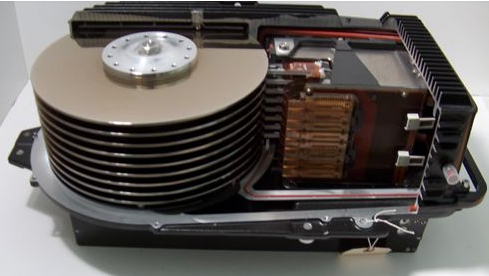History (1989): IBM 3390 HDDs Finally Arrived
1.89GB, 10.8-inch platters, 12.5ms access time, 4,260rpm, data rate up to 4.2MB/s
This is a Press Release edited by StorageNewsletter.com on October 22, 2019 at 2:18 pmFor IBM, the 3380 Winchester drive has been the HDD for mainframes in the eighties. Will the new 3390 be the same in the nineties? A possibility, but certainly not up until 2000.
About every decade, IBM launches a new gen of DASDs (Direct Access Storage Devices). The old Ramac 350 (5MB, 600ms access time) put out in 1955, was a reference in the sixties.
The 3330 (100MB, 30ms) was produced in 1970 and then was followed by the 3380 (630MB, 16ms) in 1980 and by the 3390 (1.89GB, 12.5ms) at the end of 1990.

For the 3390 model, announced last month, IBM has chosen a 10.8-inch platter, compared with the 14-inch one in the 3380, unlike some of its main competitors who manufacture compatible disks, StorageTek (14 inches), Unisys (14 inches) no longer very concerned by this matter, Amdahl (10.5 inches), Comparex/NAS/Hitachi (9.5 inches), DEC (9 inches), Imprimis/Seagate and Fujitsu (8 inches).
To improve data rate up to 4.2MB/s (compared with 3MB/s with the 3380), rotational delay has been speeded up from 3,600 to 4,260rpm. Only Imprimis/Seagate had tried to overpass 3,600rpm with its Elite drive that works at 5,400rpm. According to IBM, areal density is 70% more than with 3380K models. Average access time has improved from 16 to 12.5ms in this new series. But what might convince users is probably the gain in space since you can reach up to three times the storage capacity of a 3380K per square foot.
Will IBM’s production capacity be sufficient?
The production of 3390 drives started in 1989 and, at the time of its announcement, in November, almost 200 new DASDs were shipped, most of them inside the company. Availability is scheduled for this month, but still in limited quantities. Users, and mainly the largest ones, not to compete with well-selling 3380 models, could receive a DASD before the end of the year but will have to wait 5 to 6 months after they order for the next one.
We still have to wait to see if IBM can produce the 35,000 to 40,000 required 3890 drives in the next year, not only for its own end-users but also for some OEMs like Honeywell and Siemens already supplied with 3380s by IBM. According to the Gartner Group, the company will have placed 4,000 to 5,000 units before the end of 1989, 200 of them in USA. Some experts doubt that the San José, CA, Mainz, West Germany, and Yasu, Japan, plants will be able to produce the scheduled volumes.
A safety or worrying delay?
You can be doubtful when you see the trouble IBM had to come out with its 3390 drives in time. They should have been launched last July 25. Their announcement was delayed on account of technical problems with a material of the disk surface, aluminum particles used in lubricant coating. The new lubricant led to a 10 to 15% loss in the signal strength. Finally, IBM came back to the same lubricant used in the 3380K models and had to slightly raise the head on the disk surface. The delay in the announcement, four months, cost IBM around $1 billion. But these precautions taken by the company could also prove the reliability of the drive.
Drives that drive IBM
IBM ought to make about $7 billion income with 3390 drives in 1990, compared with $6 billion in 1989 with 3380 models. It’s considerable for the company, the equivalent of about 10% of its global income, close to $60 billion expected in 1990, and even more of its profits. IBM had officially announced that the drop in income in the third quarter of the year was partly due to the delays with the 3390 that will still affect its fourth-quarter’s revenues.
How will compatible manufacturers react?
According to the Gartner Group, manufacturers of compatible 3380 drives account for 15 to 20% of the market, with Hitachi and Fujitsu ahead. With the 3390, IBM is taking the lead in front of its competitors who are going to try to catch up soon. But this should take some time, 12 to 18 months, before they can produce compatible drives probably with smaller platters, from 8 to 9 inches. The new 3390 probably won’t last as long as the 3380, which was 9 years. You already hear about the possibility of new disk arrays from IBM, based on a stack of 5.25- inch drives. The important improvements of 5.25-inch DASDs, as well in storage capacity, access time and transfer rate, are so high that some of them already approach the performances of 10.8-inch 3390s.
This article is an abstract of news published on the former paper version of Computer Data Storage Newsletter on issue ≠23, published on December 1989.














 Subscribe to our free daily newsletter
Subscribe to our free daily newsletter


